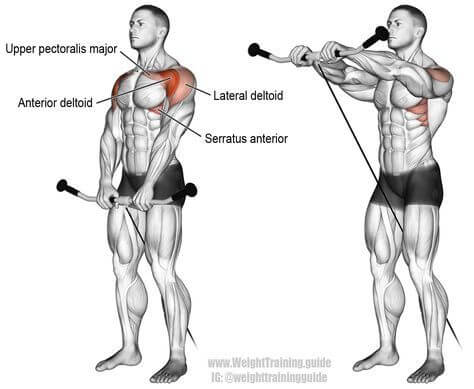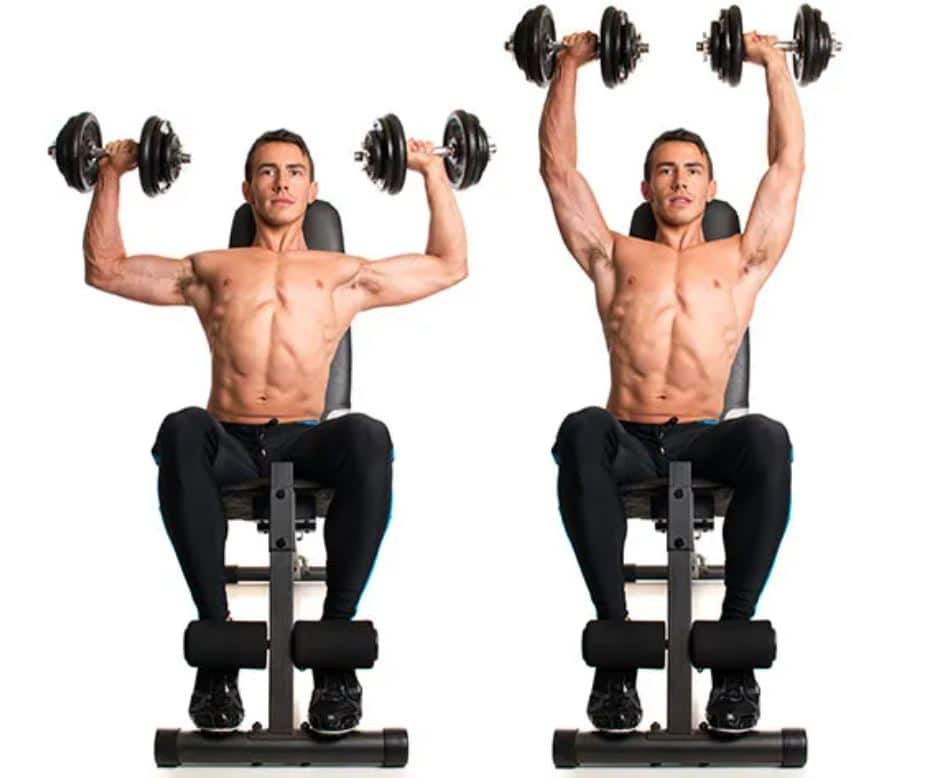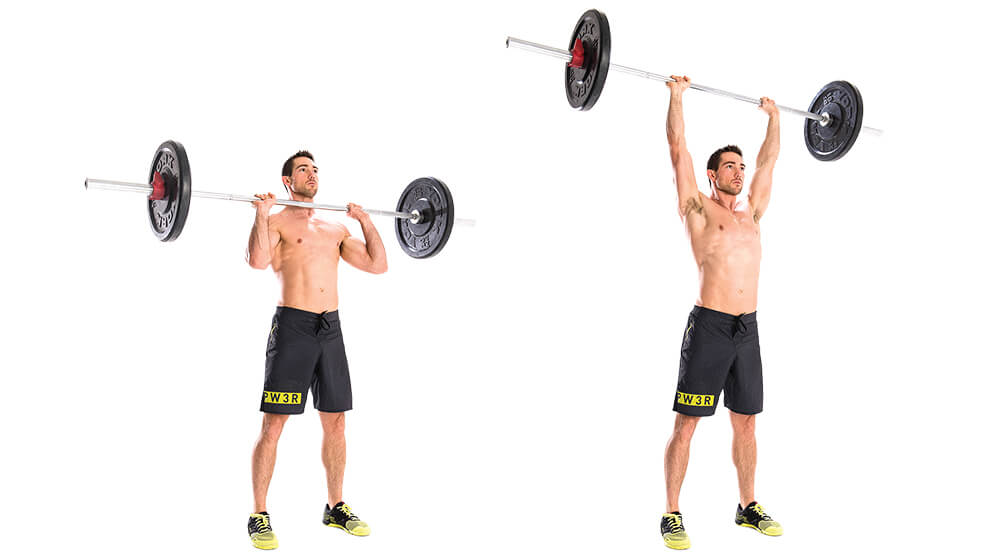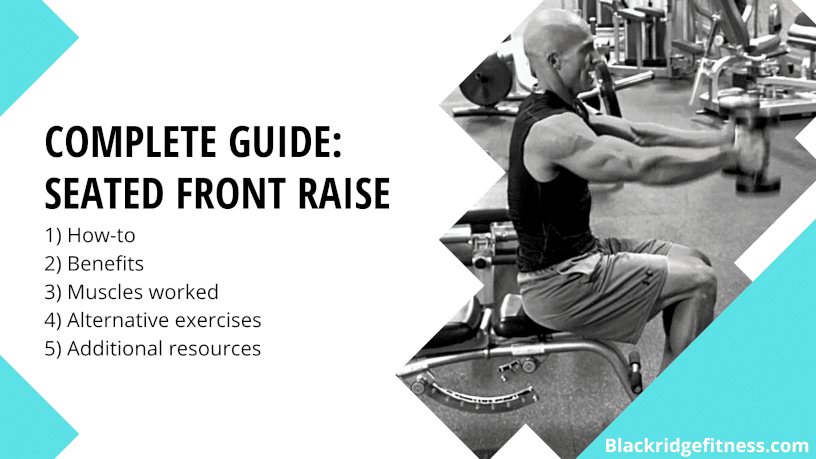Related guides: clean and press, plate front raise, shoulder press, cable y raise
The seated front raise is a brilliant way to build your front deltoid, but what makes this exercise special when there are so many exercises that offer similar muscle activation? We’ll be digging into this and much more.
Use the navigation links to skip to what you’re interested in:
- How to perform the seated front raise
- Seated front raise muscles worked
- Seated front raise benefits
- Seated front raise alternatives
- Additional helpful information
How to perform the seated front raise
1) Find a bench and dumbbells suitable for a 8 – 12 rep range. You can have back support or not when performing this exercise. A lack of back support will increase the workload on the core, making the exercise more functional. However, this lack of support will also lead to a slight decrease in performance in your font deltoid. It’s for you to choose functionality and athletic performance (no back support) over as much shoulder gains as possible. We would suggest functionality!
2) When you’re preparing to lift the weight, make sure that your back is straight, your core is engaged and your shoulder blades are back and down. This last point will put your shoulder socket in a much safer position, helping to avoid injury. Furthermore, keeping your shoulder blades back and down will help your activate your delt more and your upper pecs less.
3) Make sure that prior to lifting your arms that your palms are facing each other. We want to ensure that our palms stay in this position throughout the lift.
4) Keep your arms straight, lifting the weight to the same height as your shoulder (parallel to the ground). Ensure that you’re controlling the weight all the way up and down. Swinging the weight will lower activation on the front deltoid and increase the risk of injury

Seated front raise sets and reps
If you’re looking for hypertrophy, where we’re focusing more on muscle size due to muscle cells enlarging, perform 8 – 12 reps for 4 sets. Rest for 1 – 2 minutes between sets.
If you’re looking for strength, where we’re increasing the number of muscle cells than with hypertrophy, perform 3 – 6 reps for 4 sets. Technically with strength training you could do one rep per set. We’re recommending at least 3 because its our preference to build some size along with strength. Rest for 3 – 5 minutes between sets.
Don’t forget that hypertrophy has strength benefits, they’re just not as pronounced vs doing pure strength training (and visa versa).
Learn more about the difference between strength and hypertrophy training here.
Related guides: clean and press, plate front raise, shoulder press, cable y raise
Seated front raise muscles worked
Front deltoid (anterior head)
The deltoid is comprised of 3 main sections: the anterior head, the lateral head and the posterior head. The seated front raise is an exercise that primarily targets the anterior head (front deltoid).
The deltoid has a range of functions however the main function we’re interested in for this exercise is abduction of the arm, moving it away from the body. An important point to note is that the deltoid can only move the arm if the arm is already abducted from the body by 15%. the initial movement is produced by the supraspinatus muscle.

What other muscles are used in the seated front raise?
For starters, your supraspinatus starts the first 15% of the lift. Your lateral deltoid will all be performing stabilisation for the shoulder joint, along with other muscles in your rotator cuff.
Furthermore, your upper pecs will be assisting somewhat. Keep your shoulder blades back and down to isolate the front deltoid more.
Finally, your core and back will be stabilising your body, especially if you’re not using back support.

Seated front raise benefits
Brilliant for front delt isolation
If you’re looking to focus solely on the front delt, there are few exercises that can compete with the seated front raise. Most of our body is static, isolating the movement of one muscle in one direction. Of course the potential downside to this is that we’re not activating other muscles but this may work for you particular training program.
A useful shoulder exercise to avoid injury
The shoulder is the most mobile joint in the the body which makes it extremely susceptible to injury. Big, heavy, compound shoulder exercises can very easily lead to injury, especially with poor form or weak support muscles. This exercise is a great way to work your front delt safely and is a useful addition when recovering from injury, vs say a standing dumbbell shoulder press for example.
Seated front raise alternatives
Seated dumbbell shoulder press
This exercise once again gains the isolation benefits of the seated position. However, the key difference here is the lack of upper pec activation. Because our arms are pointing outwards more than the seated front raise, this incorporates less of the pec muscles, leaving more load for the deltoids.
When completing this lift, we don’t want our elbows to be pointing perfectly to the side (like a Texas T, or cactus). We want to bring them forward a little bit as it’s a much safe position for the shoulder joint. You can perform this exercise standing to incorporate more core activation, just be sure to drop the weight slightly.

Standing barbell press
The special thing about this front deltoid exercise is that it’s a compound movement. We’re using muscles all over the body to complete the lift which gains the various benefits of a compound movement (full body muscle growth, accessory muscle strength, more calories burned etc).
Because we’re incorporating more muscles we have to be extra carful with our form to avoid injury. Watch a YouTube video on form here.


Additional resources
- Analysis of anterior, middle and posterior deltoid activation during single and multijoint exercises
- Dynamite Delts: ACE Research Identifies Top Shoulder Exercises
- Comparison among the EMG Activity of the Anterior Deltoid and Medial Deltoid During Two Variations of Dumbbell Shoulder Press Exercise
- Related guides: clean and press, plate front raise, shoulder press, cable y raise

Olly is a CIMSPA accredited personal trainer with a BSc degree in sport management from Solent University. He has over 10 years experience helping clients reach their health & fitness goals.

